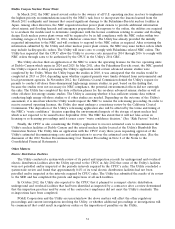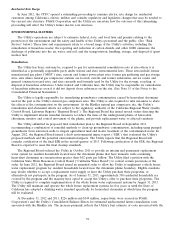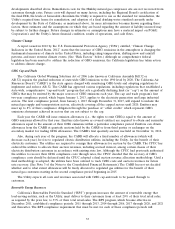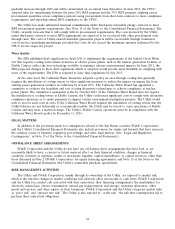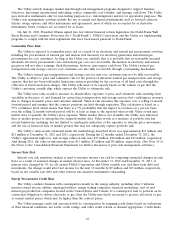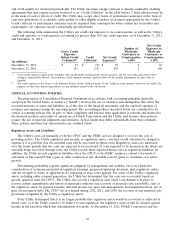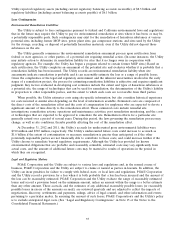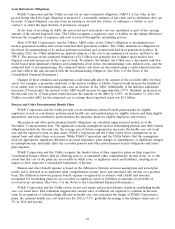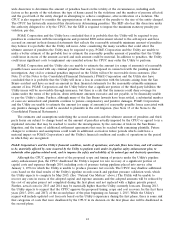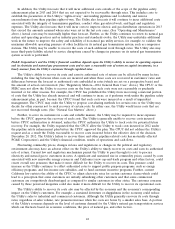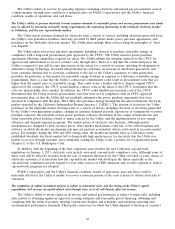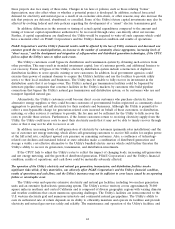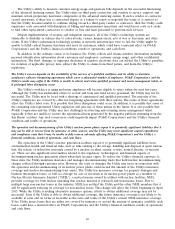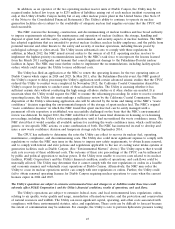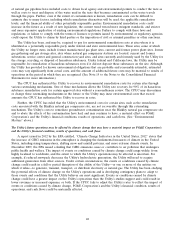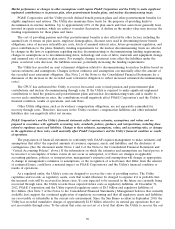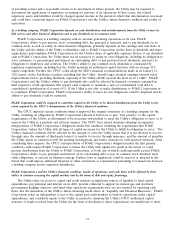PG&E 2012 Annual Report Download - page 45
Download and view the complete annual report
Please find page 45 of the 2012 PG&E annual report below. You can navigate through the pages in the report by either clicking on the pages listed below, or by using the keyword search tool below to find specific information within the annual report.wide discretion to determine the amount of penalties based on the totality of the circumstances, including such
factors as the gravity of the violations; the type of harm caused by the violations and the number of persons affected;
and the good faith of the entity charged in attempting to achieve compliance, after notification of a violation. The
CPUC is also required to consider the appropriateness of the amount of the penalty to the size of the entity charged.
The CPUC has historically exercised this discretion in determining penalties. The SED also has this discretion under
the authority delegated to it by the CPUC, but the SED is required to impose the maximum statutory penalty per
violation, per day.
PG&E Corporation and the Utility have concluded that it is probable that the Utility will be required to pay
penalties in connection with the investigations and potential SED enforcement related to the self-reports and have
accrued an amount in their financial statements that reflects the reasonably estimable minimum amount of penalties
they believe it is probable that the Utility will incur. After considering the many variables that could affect the
ultimate amount of penalties the Utility may be required to pay, PG&E Corporation and the Utility are unable to
make a better estimate of the probable loss or estimate the reasonably possible amount of penalties that the Utility
could incur in excess of the amount accrued and such amount could be material. In addition to penalties, the Utility
could incur significant costs to implement any remedial actions the CPUC may order the Utility to perform.
PG&E Corporation and the Utility also are unable to estimate the amount (or range of amounts) of reasonably
possible losses associated with any criminal penalties that may be imposed in connection with the pending criminal
investigation. Any civil or criminal penalties imposed on the Utility will not be recoverable from customers. (See
Note 15 of the Notes to the Consolidated Financial Statements.) PG&E Corporation and the Utility also have
concluded that it is probable that the Utility will incur a loss in connection with the lawsuits arising from the San
Bruno accident and have accrued an amount in their financial statements for the reasonably estimable minimum
amount of loss. PG&E Corporation and the Utility believe that a significant portion of the third-party liabilities the
Utility incurs will be recoverable through insurance, but there is a risk that the insurers could deny coverage for
claims under the terms of the policies, deem settlement amounts excessive and not payable, or be financially unable
to pay the Utility’s claims. Further, although many of the San Bruno lawsuits have been settled, a substantial number
of cases are unresolved and plaintiffs continue to pursue compensatory and punitive damages. PG&E Corporation
and the Utility are unable to estimate the amount (or range of amounts) of reasonably possible losses associated with
any punitive damages that could be awarded to plaintiffs in the civil litigation. (See Note 15 of the Notes to the
Consolidated Financial Statements.)
The estimates and assumptions underlying the accrued amounts and the ultimate amount of penalties and third-
party losses are subject to change based on the amount of penalties actually imposed by the CPUC or agreed to in a
stipulated outcome that may be reached to resolve the investigations, by the outcome of trials in the San Bruno
litigation, and the terms of additional settlement agreements that may be reached with remaining plaintiffs. Future
changes to estimates and assumptions could result in additional accruals in future periods which could have a
material impact on PG&E Corporation’s and the Utility’s financial condition and results of operations in the period
in which they are recognized.
PG&E Corporation’s and the Utility’s financial condition, results of operations, and cash flows have been, and will continue
to be, materially affected by costs incurred by the Utility to perform work under its pipeline safety enhancement plan, to
undertake other pipeline-related work, and to improve the safety and reliability of its natural gas and electricity operations.
Although the CPUC approved most of the proposed scope and timing of projects under the Utility’s pipeline
safety enhancement plan, the CPUC disallowed the Utility’s request for rate recovery of a significant portion of
capital costs and expenses through 2014, including costs of pressure testing pipelines placed into service after
January 1, 1956 for which the Utility is unable to produce pressure test records. The CPUC may disallow additional
costs based on the final results of the Utility’s pipeline records search and pipeline pressure validation work, which
the Utility expects to complete by May 2013. (See ‘‘Natural Gas Matters’’ above.) The Utility will be unable to
recover any costs in excess of the adopted capital and expense amounts and the adopted amounts will be reduced by
the cost of any plan project not completed during the first phase and not replaced with a higher priority project.
Further, actual costs for 2013 and 2014 may be materially higher than the Utility currently forecasts. During 2013,
the Utility expects to request that the CPUC approve the proposed timing, scope and cost recovery for the first three
years (2015, 2016, and 2017) of the second phase of the plan beginning on January 1, 2015. While the Utility’s
request will include updated cost forecasts based on the Utility’s experience during the first phase, there is some risk
that categories of costs that were disallowed by the CPUC in its decision on the first phase also will be disallowed in
the second phase.
41


